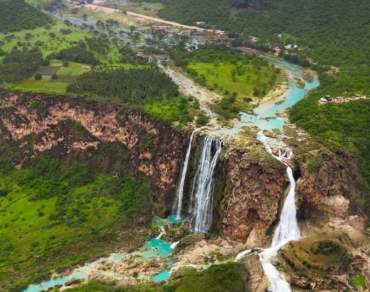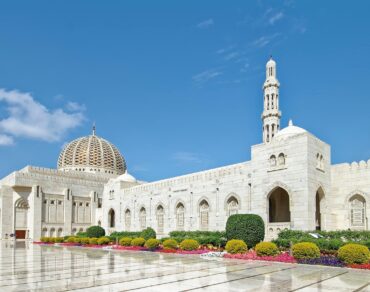
-
Oman Tour Packages > Wiki > Why Khasab Fort Should Be on Your Oman Travel List: A Local’s Story
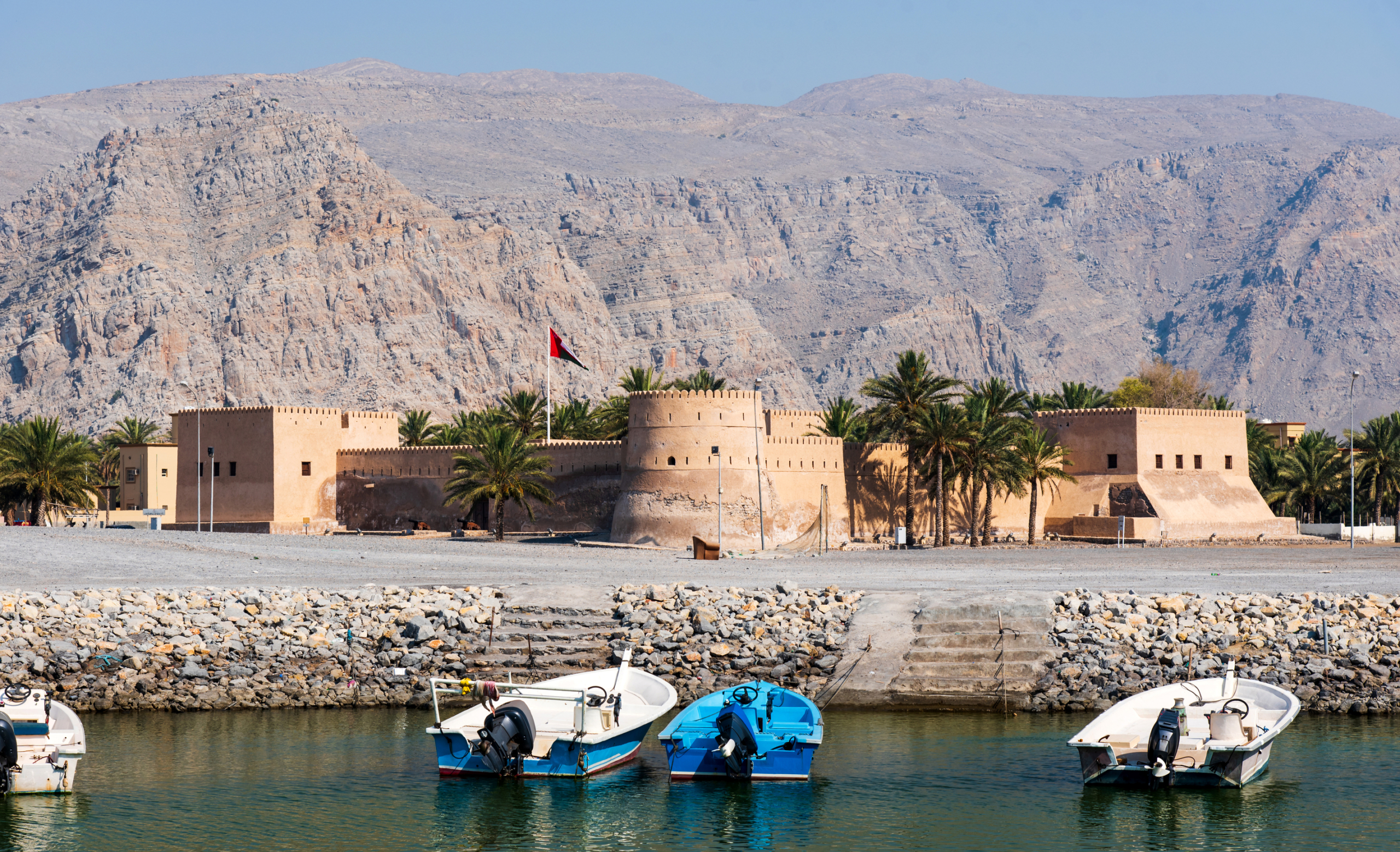
Why Khasab Fort Should Be on Your Oman Travel List: A Local’s Story
The majestic Khasab Fort Oman rises above what visitors call the “Norway of Arabia,” where stunning fjord-like inlets meet dramatic mountain peaks. This 17th-century Portuguese fortress has earned a remarkable 4.5-star rating from 178 visitors, proving it’s much more than a typical historical landmark.
The architectural masterpiece now houses one of Oman’s finest small ethnographic museums after careful restoration. Its four stone turrets and central tower bring the peninsula’s rich flora and fauna to life. Local fishermen’s traditional sea chants echo through its halls, preserving their authentic voices.
My time learning about this historic castle revealed excellent information plaques that tell fascinating stories. The ancient corridors hold layers of Portuguese influence and Omani heritage. This piece shares my personal experience and shows why this fort deserves prime placement on your Oman travel plans.
My First Visit to Khasab Fort
The entrance of Khasab Fort stands opposite the modern Lulu Hypermarket, creating a striking portal to the 17th century. Modern surroundings and ancient stonework created an immediate contrast that caught my attention.
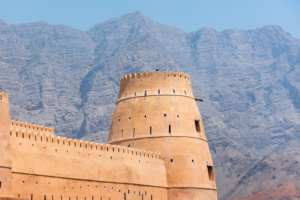 Walking through ancient gates
The square-shaped outer walls led to a courtyard dominated by a cylindrical central tower. Portuguese builders showed their military brilliance through the fort’s strategic design – four main strongholds protecting the central refuge tower.
The fort’s story evolved remarkably over time. It started as a military base against Portuguese forces, then became Khasab’s Wali’s residence and the city prison. Renovations in 1990 and 2007 have kept these historical layers intact.
Three traditional Omani boats from Kamzar village stood in the courtyard among other ancient cannons guarding the entrance. The fort’s defensive capabilities shone through its architectural elements – thick stone walls built with local materials like mudbrick and wood.
Meeting the local guide
A knowledgeable guide made the fort’s history come alive. The guide taught me about complex defense systems, especially the circular tower that protected inhabitants during sieges. Restored decorative elements revealed the builders’ religious beliefs and artistic sensibilities through traditional carvings and inscriptions.
Each chamber told its own story as we walked through. One room showcased traditional weapons and maritime artifacts. The model of a traditional elevated summer house and the ancient date storage facility, Bait Al Quful, really sparked my interest.
The fort’s strategic location helped protect trade routes and monitor ships, as my guide explained. Displays featured marriage jewelry, massive dowry chests, and fascinating household items that painted a vivid picture of ancient Omani life.
The guide’s explanation of food storage chambers’ traditional locking systems showed the ingenious security measures of the past. Bamboo houses in the courtyard showed how locals created comfortable spaces with simple materials to beat the intense heat.
Walking through ancient gates
The square-shaped outer walls led to a courtyard dominated by a cylindrical central tower. Portuguese builders showed their military brilliance through the fort’s strategic design – four main strongholds protecting the central refuge tower.
The fort’s story evolved remarkably over time. It started as a military base against Portuguese forces, then became Khasab’s Wali’s residence and the city prison. Renovations in 1990 and 2007 have kept these historical layers intact.
Three traditional Omani boats from Kamzar village stood in the courtyard among other ancient cannons guarding the entrance. The fort’s defensive capabilities shone through its architectural elements – thick stone walls built with local materials like mudbrick and wood.
Meeting the local guide
A knowledgeable guide made the fort’s history come alive. The guide taught me about complex defense systems, especially the circular tower that protected inhabitants during sieges. Restored decorative elements revealed the builders’ religious beliefs and artistic sensibilities through traditional carvings and inscriptions.
Each chamber told its own story as we walked through. One room showcased traditional weapons and maritime artifacts. The model of a traditional elevated summer house and the ancient date storage facility, Bait Al Quful, really sparked my interest.
The fort’s strategic location helped protect trade routes and monitor ships, as my guide explained. Displays featured marriage jewelry, massive dowry chests, and fascinating household items that painted a vivid picture of ancient Omani life.
The guide’s explanation of food storage chambers’ traditional locking systems showed the ingenious security measures of the past. Bamboo houses in the courtyard showed how locals created comfortable spaces with simple materials to beat the intense heat.
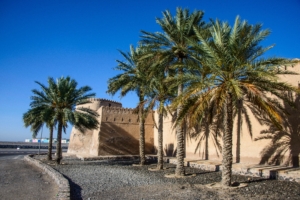 The Fort’s Hidden Stories
The memories of my grandfather’s ancient tales flood back as I sit in the fort’s central courtyard. The circular watchtower stands tall, a silent witness to history since before the Portuguese arrived in the 17th century.
Tales from my grandfather
My grandfather would tell stories about the fort’s transition from Portuguese to Omani control around 1624. The sort of thing I love was learning about the fort’s role as a supply point where Portuguese ships would stock up on dates and water while sailing through the Strait of Hormuz.
The central tower now showcases local flora and fauna exhibits, but it served as the final sanctuary during sieges. My grandfather told me how guards used the tower’s strategic position to spot threats miles away, which protected the town and its vital trade routes.
Life in old Khasab
The fort’s courtyard offers glimpses into historical daily life. The Bait Al Qufl, which means ‘house of locks,’ shows the brilliant architectural solutions from ancient Khasab. These homes had floors built well below ground level – a smart design that kept properties safe when families moved to the shore during fishing and date harvesting seasons.
Traditional boats from Kumzar village – Battil, Mashuwwah, and Zaruqah – are proudly displayed in the museum. The Zaruqah class vessels, built in Khasab during the early 1900s, still navigate Musandam’s bays today.
The museum chambers showcase:
The Fort’s Hidden Stories
The memories of my grandfather’s ancient tales flood back as I sit in the fort’s central courtyard. The circular watchtower stands tall, a silent witness to history since before the Portuguese arrived in the 17th century.
Tales from my grandfather
My grandfather would tell stories about the fort’s transition from Portuguese to Omani control around 1624. The sort of thing I love was learning about the fort’s role as a supply point where Portuguese ships would stock up on dates and water while sailing through the Strait of Hormuz.
The central tower now showcases local flora and fauna exhibits, but it served as the final sanctuary during sieges. My grandfather told me how guards used the tower’s strategic position to spot threats miles away, which protected the town and its vital trade routes.
Life in old Khasab
The fort’s courtyard offers glimpses into historical daily life. The Bait Al Qufl, which means ‘house of locks,’ shows the brilliant architectural solutions from ancient Khasab. These homes had floors built well below ground level – a smart design that kept properties safe when families moved to the shore during fishing and date harvesting seasons.
Traditional boats from Kumzar village – Battil, Mashuwwah, and Zaruqah – are proudly displayed in the museum. The Zaruqah class vessels, built in Khasab during the early 1900s, still navigate Musandam’s bays today.
The museum chambers showcase:
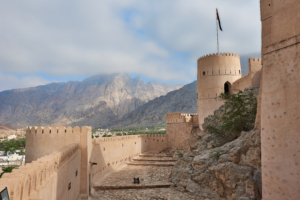 Portuguese legacy today
Portuguese influence shapes the fort’s architecture. The military engineering of that era shines through four stone turrets and distinctive crenellations. The fort served two purposes – it protected against raiders and monitored maritime traffic through the strategic Strait of Hormuz.
Restoration work in 1990 and 2007 preserved both Portuguese military elements and traditional Omani design features. This blend appears in the materials used – stone walls merge seamlessly with local mudbrick and wooden elements.
The fort houses one of Oman’s finest ethnographic museums. Visitors can explore unique features like the arish – a traditional house on stilts that helps curb summer heat. History enthusiasts can find similar historical houses in Rawdah Bowl, which is available through a two-hour off-road mountain drive.
The fort’s impact reaches beyond its walls. It tells the story of Khasab’s evolution from a strategic Portuguese outpost to a vital Omani administrative center. The Governorate of Musandam, through landmarks like Khasab Fort, maintains Oman’s significant position along the Strait of Hormuz, where more than 20% of global crude oil supplies pass daily.
Portuguese legacy today
Portuguese influence shapes the fort’s architecture. The military engineering of that era shines through four stone turrets and distinctive crenellations. The fort served two purposes – it protected against raiders and monitored maritime traffic through the strategic Strait of Hormuz.
Restoration work in 1990 and 2007 preserved both Portuguese military elements and traditional Omani design features. This blend appears in the materials used – stone walls merge seamlessly with local mudbrick and wooden elements.
The fort houses one of Oman’s finest ethnographic museums. Visitors can explore unique features like the arish – a traditional house on stilts that helps curb summer heat. History enthusiasts can find similar historical houses in Rawdah Bowl, which is available through a two-hour off-road mountain drive.
The fort’s impact reaches beyond its walls. It tells the story of Khasab’s evolution from a strategic Portuguese outpost to a vital Omani administrative center. The Governorate of Musandam, through landmarks like Khasab Fort, maintains Oman’s significant position along the Strait of Hormuz, where more than 20% of global crude oil supplies pass daily.
 Inside the Living Museum
The fort houses one of the region’s best small museums. Its exhibits take visitors on a journey through time and give intimate glimpses into Omani life through generations.
Traditional house secrets
The Bait Al Qufl stands out as one of the most remarkable displays in the courtyard. This traditional “house of locks” shows incredible architectural creativity. Its ground floor sits below ground level, which helped families protect their belongings when they moved to the shore for fishing and date harvesting.
The arish caught my eye – a unique house that sits on stilts. Its clever design lets air flow freely and provides natural cooling during hot summer months. This design shows how ancient Omanis adapted to extreme weather.
Daily life exhibits
Several beautifully restored rooms make up the museum’s collection. Each room tells its story through:
Inside the Living Museum
The fort houses one of the region’s best small museums. Its exhibits take visitors on a journey through time and give intimate glimpses into Omani life through generations.
Traditional house secrets
The Bait Al Qufl stands out as one of the most remarkable displays in the courtyard. This traditional “house of locks” shows incredible architectural creativity. Its ground floor sits below ground level, which helped families protect their belongings when they moved to the shore for fishing and date harvesting.
The arish caught my eye – a unique house that sits on stilts. Its clever design lets air flow freely and provides natural cooling during hot summer months. This design shows how ancient Omanis adapted to extreme weather.
Daily life exhibits
Several beautifully restored rooms make up the museum’s collection. Each room tells its story through:
 Walking through ancient gates
The square-shaped outer walls led to a courtyard dominated by a cylindrical central tower. Portuguese builders showed their military brilliance through the fort’s strategic design – four main strongholds protecting the central refuge tower.
The fort’s story evolved remarkably over time. It started as a military base against Portuguese forces, then became Khasab’s Wali’s residence and the city prison. Renovations in 1990 and 2007 have kept these historical layers intact.
Three traditional Omani boats from Kamzar village stood in the courtyard among other ancient cannons guarding the entrance. The fort’s defensive capabilities shone through its architectural elements – thick stone walls built with local materials like mudbrick and wood.
Meeting the local guide
A knowledgeable guide made the fort’s history come alive. The guide taught me about complex defense systems, especially the circular tower that protected inhabitants during sieges. Restored decorative elements revealed the builders’ religious beliefs and artistic sensibilities through traditional carvings and inscriptions.
Each chamber told its own story as we walked through. One room showcased traditional weapons and maritime artifacts. The model of a traditional elevated summer house and the ancient date storage facility, Bait Al Quful, really sparked my interest.
The fort’s strategic location helped protect trade routes and monitor ships, as my guide explained. Displays featured marriage jewelry, massive dowry chests, and fascinating household items that painted a vivid picture of ancient Omani life.
The guide’s explanation of food storage chambers’ traditional locking systems showed the ingenious security measures of the past. Bamboo houses in the courtyard showed how locals created comfortable spaces with simple materials to beat the intense heat.
Walking through ancient gates
The square-shaped outer walls led to a courtyard dominated by a cylindrical central tower. Portuguese builders showed their military brilliance through the fort’s strategic design – four main strongholds protecting the central refuge tower.
The fort’s story evolved remarkably over time. It started as a military base against Portuguese forces, then became Khasab’s Wali’s residence and the city prison. Renovations in 1990 and 2007 have kept these historical layers intact.
Three traditional Omani boats from Kamzar village stood in the courtyard among other ancient cannons guarding the entrance. The fort’s defensive capabilities shone through its architectural elements – thick stone walls built with local materials like mudbrick and wood.
Meeting the local guide
A knowledgeable guide made the fort’s history come alive. The guide taught me about complex defense systems, especially the circular tower that protected inhabitants during sieges. Restored decorative elements revealed the builders’ religious beliefs and artistic sensibilities through traditional carvings and inscriptions.
Each chamber told its own story as we walked through. One room showcased traditional weapons and maritime artifacts. The model of a traditional elevated summer house and the ancient date storage facility, Bait Al Quful, really sparked my interest.
The fort’s strategic location helped protect trade routes and monitor ships, as my guide explained. Displays featured marriage jewelry, massive dowry chests, and fascinating household items that painted a vivid picture of ancient Omani life.
The guide’s explanation of food storage chambers’ traditional locking systems showed the ingenious security measures of the past. Bamboo houses in the courtyard showed how locals created comfortable spaces with simple materials to beat the intense heat.
 The Fort’s Hidden Stories
The memories of my grandfather’s ancient tales flood back as I sit in the fort’s central courtyard. The circular watchtower stands tall, a silent witness to history since before the Portuguese arrived in the 17th century.
Tales from my grandfather
My grandfather would tell stories about the fort’s transition from Portuguese to Omani control around 1624. The sort of thing I love was learning about the fort’s role as a supply point where Portuguese ships would stock up on dates and water while sailing through the Strait of Hormuz.
The central tower now showcases local flora and fauna exhibits, but it served as the final sanctuary during sieges. My grandfather told me how guards used the tower’s strategic position to spot threats miles away, which protected the town and its vital trade routes.
Life in old Khasab
The fort’s courtyard offers glimpses into historical daily life. The Bait Al Qufl, which means ‘house of locks,’ shows the brilliant architectural solutions from ancient Khasab. These homes had floors built well below ground level – a smart design that kept properties safe when families moved to the shore during fishing and date harvesting seasons.
Traditional boats from Kumzar village – Battil, Mashuwwah, and Zaruqah – are proudly displayed in the museum. The Zaruqah class vessels, built in Khasab during the early 1900s, still navigate Musandam’s bays today.
The museum chambers showcase:
The Fort’s Hidden Stories
The memories of my grandfather’s ancient tales flood back as I sit in the fort’s central courtyard. The circular watchtower stands tall, a silent witness to history since before the Portuguese arrived in the 17th century.
Tales from my grandfather
My grandfather would tell stories about the fort’s transition from Portuguese to Omani control around 1624. The sort of thing I love was learning about the fort’s role as a supply point where Portuguese ships would stock up on dates and water while sailing through the Strait of Hormuz.
The central tower now showcases local flora and fauna exhibits, but it served as the final sanctuary during sieges. My grandfather told me how guards used the tower’s strategic position to spot threats miles away, which protected the town and its vital trade routes.
Life in old Khasab
The fort’s courtyard offers glimpses into historical daily life. The Bait Al Qufl, which means ‘house of locks,’ shows the brilliant architectural solutions from ancient Khasab. These homes had floors built well below ground level – a smart design that kept properties safe when families moved to the shore during fishing and date harvesting seasons.
Traditional boats from Kumzar village – Battil, Mashuwwah, and Zaruqah – are proudly displayed in the museum. The Zaruqah class vessels, built in Khasab during the early 1900s, still navigate Musandam’s bays today.
The museum chambers showcase:
- Traditional weapons and maritime artifacts
- Ancient household items and wedding decorations
- Historical documents and Quran learning materials
 Portuguese legacy today
Portuguese influence shapes the fort’s architecture. The military engineering of that era shines through four stone turrets and distinctive crenellations. The fort served two purposes – it protected against raiders and monitored maritime traffic through the strategic Strait of Hormuz.
Restoration work in 1990 and 2007 preserved both Portuguese military elements and traditional Omani design features. This blend appears in the materials used – stone walls merge seamlessly with local mudbrick and wooden elements.
The fort houses one of Oman’s finest ethnographic museums. Visitors can explore unique features like the arish – a traditional house on stilts that helps curb summer heat. History enthusiasts can find similar historical houses in Rawdah Bowl, which is available through a two-hour off-road mountain drive.
The fort’s impact reaches beyond its walls. It tells the story of Khasab’s evolution from a strategic Portuguese outpost to a vital Omani administrative center. The Governorate of Musandam, through landmarks like Khasab Fort, maintains Oman’s significant position along the Strait of Hormuz, where more than 20% of global crude oil supplies pass daily.
Portuguese legacy today
Portuguese influence shapes the fort’s architecture. The military engineering of that era shines through four stone turrets and distinctive crenellations. The fort served two purposes – it protected against raiders and monitored maritime traffic through the strategic Strait of Hormuz.
Restoration work in 1990 and 2007 preserved both Portuguese military elements and traditional Omani design features. This blend appears in the materials used – stone walls merge seamlessly with local mudbrick and wooden elements.
The fort houses one of Oman’s finest ethnographic museums. Visitors can explore unique features like the arish – a traditional house on stilts that helps curb summer heat. History enthusiasts can find similar historical houses in Rawdah Bowl, which is available through a two-hour off-road mountain drive.
The fort’s impact reaches beyond its walls. It tells the story of Khasab’s evolution from a strategic Portuguese outpost to a vital Omani administrative center. The Governorate of Musandam, through landmarks like Khasab Fort, maintains Oman’s significant position along the Strait of Hormuz, where more than 20% of global crude oil supplies pass daily.
 Inside the Living Museum
The fort houses one of the region’s best small museums. Its exhibits take visitors on a journey through time and give intimate glimpses into Omani life through generations.
Traditional house secrets
The Bait Al Qufl stands out as one of the most remarkable displays in the courtyard. This traditional “house of locks” shows incredible architectural creativity. Its ground floor sits below ground level, which helped families protect their belongings when they moved to the shore for fishing and date harvesting.
The arish caught my eye – a unique house that sits on stilts. Its clever design lets air flow freely and provides natural cooling during hot summer months. This design shows how ancient Omanis adapted to extreme weather.
Daily life exhibits
Several beautifully restored rooms make up the museum’s collection. Each room tells its story through:
Inside the Living Museum
The fort houses one of the region’s best small museums. Its exhibits take visitors on a journey through time and give intimate glimpses into Omani life through generations.
Traditional house secrets
The Bait Al Qufl stands out as one of the most remarkable displays in the courtyard. This traditional “house of locks” shows incredible architectural creativity. Its ground floor sits below ground level, which helped families protect their belongings when they moved to the shore for fishing and date harvesting.
The arish caught my eye – a unique house that sits on stilts. Its clever design lets air flow freely and provides natural cooling during hot summer months. This design shows how ancient Omanis adapted to extreme weather.
Daily life exhibits
Several beautifully restored rooms make up the museum’s collection. Each room tells its story through:
- Maritime artifacts that showcase Musandam’s seafaring heritage
- Traditional weapons and household tools
- Authentic costumes and jewelry from past eras
- Archeological finds that tell the peninsula’s story
- Traditional dance performances like Al Ayallah
- Local artisan craft exhibitions
- Authentic Omani culinary experiences
Related Tours
Related Tours
Test2
© 2025 Oman Tour Packages. All rights reserved.
